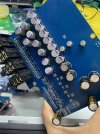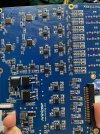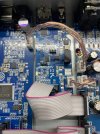Opa1656 is indeed slightly inferior to opa1612 in terms of measurement, but it does make people feel more comfortable in terms of sound and music sensation. After all, the HTX index is already high enough. Replacing opa1612 should be an improvement in my subjective listening experience.
If there is indeed a problem after replacement, then I can replace it again.
I did not change any capacitance or specifications for the other capacitors, but selected Panasonic's polymer capacitor through bridge measurement, which has better ESR and D values.



